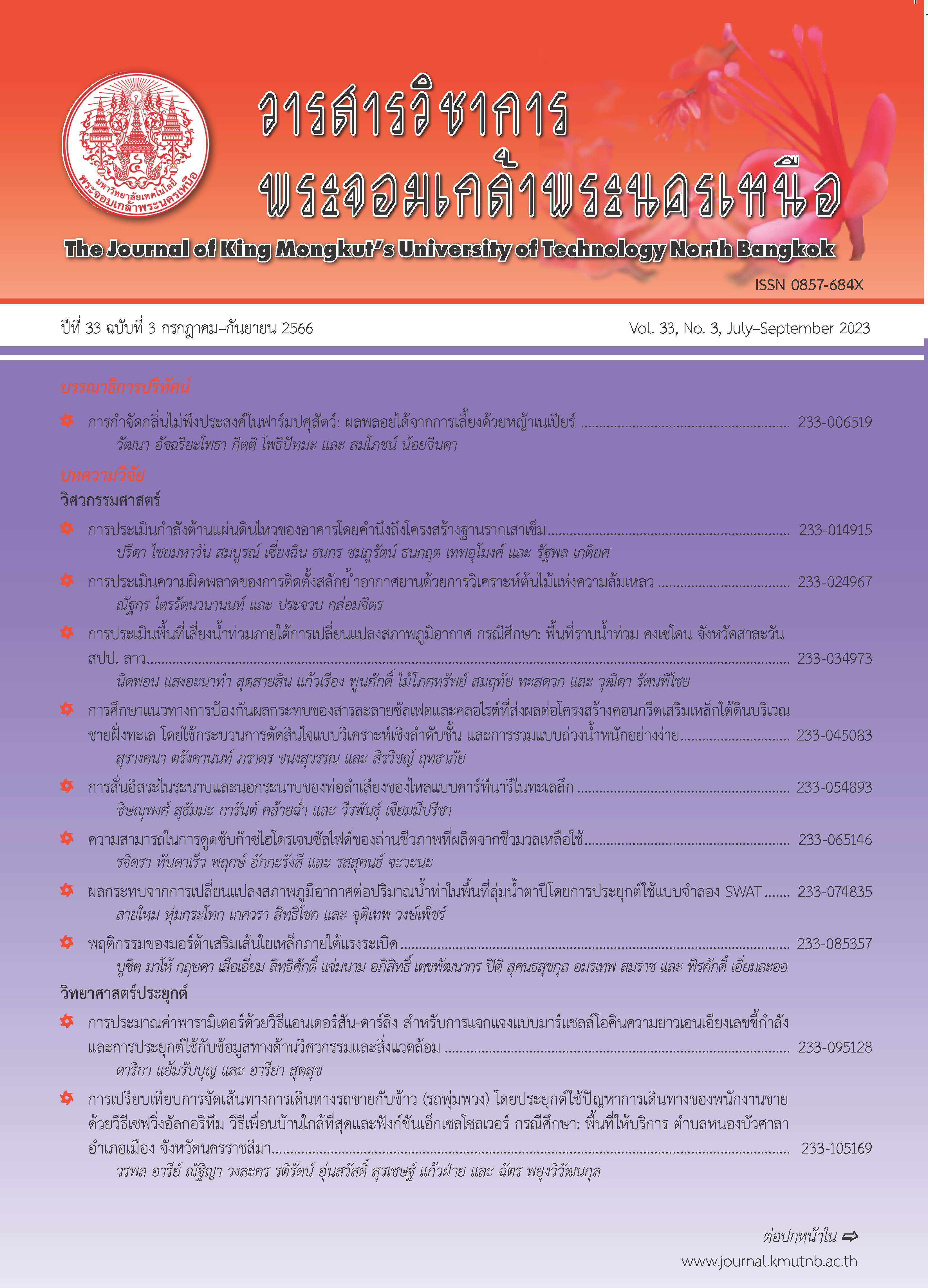แบบจำลองสำหรับค่าสุดขีด: แบบจำลองสถิติอันดับ r อันดับที่ใหญ่ที่สุด
Main Article Content
บทคัดย่อ
การวิเคราะห์ค่าสุดขีด (Extreme Value Analysis) เป็นการวิเคราะห์ข้อมูลที่มีค่าสูงสุดหรือต่ำสุด โดยเป็นข้อมูลที่อยู่ในส่วนปลายหางของข้อมูลซึ่งมีจำนวนข้อมูลน้อยมาก ทำให้ผลของการวิเคราะห์มีความคลาดเคลื่อนส่งผลต่อการประมาณค่าพารามิเตอร์ของแบบจำลองที่ผิดพลาดและการประมาณระดับการเกิดซ้ำไม่แม่นยำเท่าที่ควร ดังนั้นการลดความคลาดเคลื่อนที่เกิดจากการมีจำนวนข้อมูลน้อยจึงมีความจำเป็นอย่างยิ่ง ซึ่งวิธีการที่ใช้กันอย่างแพร่หลาย คือ การเพิ่มขนาดหรือเพิ่มจำนวนข้อมูล เป็นการเพิ่มข้อมูลเข้าไปในการวิเคราะห์ค่าสุดขีด ซึ่งจะสามารถเพิ่มได้เฉพาะกรณีที่ผู้วิเคราะห์เลือกใช้วิธีบล็อกเวลา (Block Time Method) ในการวิเคราะห์เท่านั้น โดยการแจกแจงที่ใช้ในกรณีนี้เรียกว่า การแจกแจงค่าสุดขีดนัยทั่วไปสำหรับสถิติอันดับ r อันดับที่ใหญ่ที่สุด (Generalized Extreme Value Distribution for the r Largest Order Statistics; GEVr) ถือว่าเป็นวิธีการที่จะทำให้แบบจำลองที่ได้จากการวิเคราะห์นี้มีความเหมาะสมกับข้อมูลมากขึ้น และการประมาณค่าพารามิเตอร์และการประมาณระดับการเกิดซ้ำแม่นยำมากยิ่งขึ้น
Article Details

อนุญาตภายใต้เงื่อนไข Creative Commons Attribution-NonCommercial-NoDerivatives 4.0 International License.
บทความที่ลงตีพิมพ์เป็นข้อคิดเห็นของผู้เขียนเท่านั้น
ผู้เขียนจะต้องเป็นผู้รับผิดชอบต่อผลทางกฎหมายใดๆ ที่อาจเกิดขึ้นจากบทความนั้น
เอกสารอ้างอิง
P. Busababodhin and A. Keawmun, “Extreme values statistics,” The Journal of KMUTNB, vol. 25, no. 2, pp. 55–65, 2015 (in Thai)
S. Kotz and S. Nadaraja, Extreme Value Distributions: Theory and Applications, Singapore: Imperial College Press, 2000.
J. Beirlant, Y. Goegebeur, J. Segers, J. Teugels, D. D. Waal, and C. Ferro, Statistics of Extremes: Theory and Applications, New York: John Wiley & Sons, 2004.
S. Coles, An Introduction to Statistical Modeling of Extreme Values, London: Springer-Varlag, 2001.
S. Coles and S. Nadaraja, An Introduction to Statistical Modeling of Extreme Values, Great Britain: Springer-Varlag London Limited, 2001.
P. Embrecht, C. Kluppelberg, and T. Mikosch, Modeling extremal events for insurance and finance, Berlin: Springer Verlag, 1997.
E. J. Gumbel, Statistics of Extremes, New York: Columbia University Press, 1958.
J. Galambos, The asymptotic theory of extreme order statistics, New York: Wiley, 1978.
P. Guayjarernpanishk, T Phupiewpha, and P. Busababodhin, “Extreme value analysis: Non–stationary process,” The Journal of KMUTNB, vol. 32, no. 2, 2021 (in Thai).
B. Finkenstadt and H. Rootzen, Extreme values in finance, telecommunications, and the environment, London: Chapman and Hall/CRC Press, 2004.
P. Amphanthong and P. Busababodhin, “Modeling and prediction of exchange rate and billion gold price of Thailand,” International Journal of Statistics and Economics, vol. 16, no. 3, pp. 81–92, 2015.
P. Busababodhin, “Modeling on maximum rainfall and temperature based on extreme value copula analysis,” in Proceeding of 10th Conference on Extreme Value Analysis (EVA2017), 2017, pp. 14.
R. D. Reiss and M. Thomas, Statistical Analysis of Extremes value with Applications to Insurance, Finance, Hydrology and Other Fields, Germany: Springer, 2007.
T. An and M. D. Pandey, “A comparison of methods of extreme wind speed estimation,” Technical note Journal of Wind Engineering and Industrial Aerodynamics, vol. 93, no. 7, pp. 535–545, 2005.
A. F. Jenkinson, “The frequency distribution of the annual maximum (or minimum) values of meteorological elements,” Quarterly Journal of the Royal Meteorological Society, vol. 81, no. 348, pp. 158–171, 1955.
M. M. Nemukula and C. Sigauke, “Modelling average maximum daily temperature using r largest order statistics: An application to South African data,” Jàmbá: Journal of Disaster Risk Studies, vol. 10, no. 1, pp. 1–11, 2018.
Meteorological Department of Thailand. (2021, May). Thailand and Around Area Earthquake Report. Bangkok, Thailand [Online] (in Thai). Available: https://www.tmd.go.th

